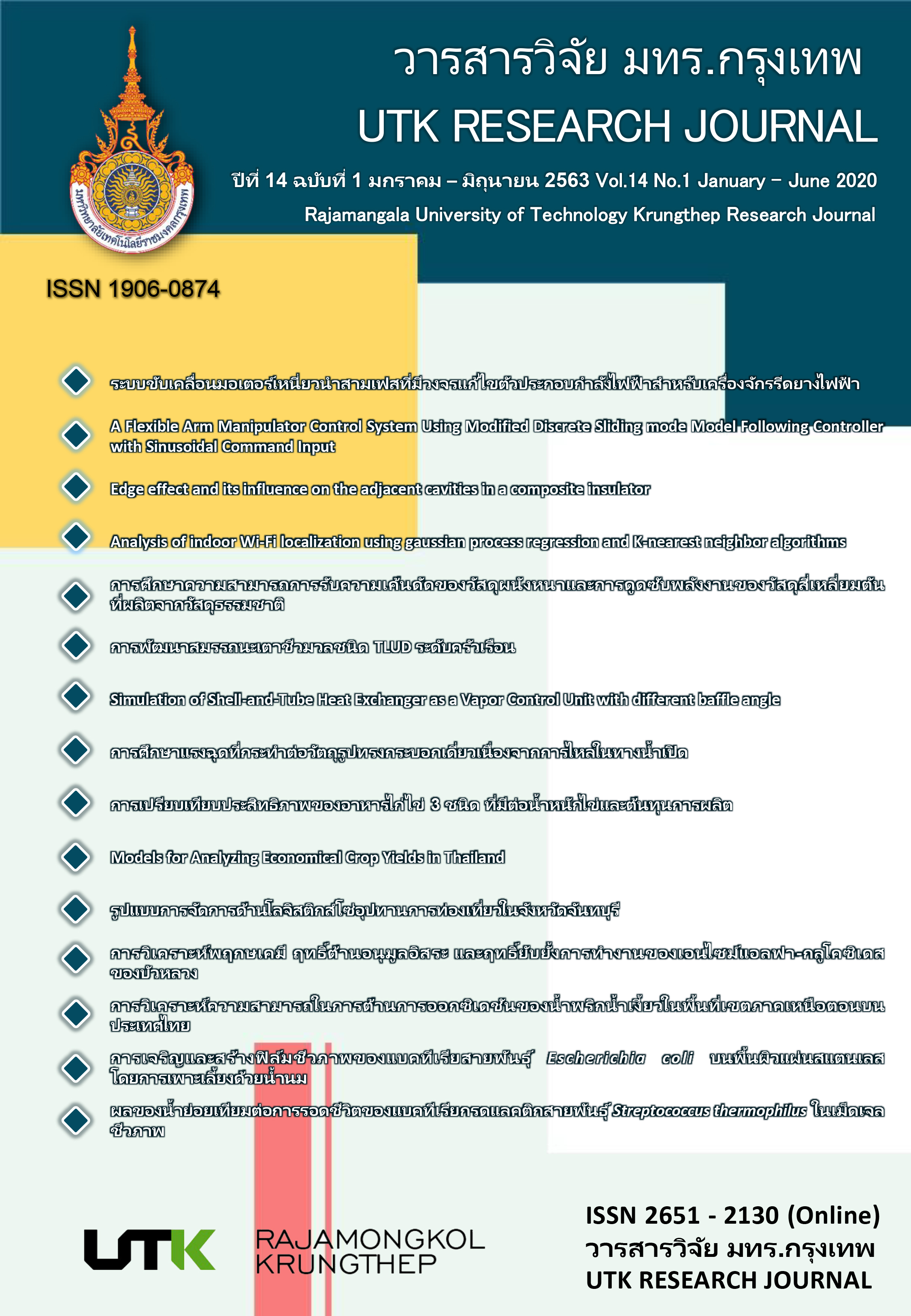ผลของน้ำย่อยเทียมต่อการรอดชีวิตของแบคทีเรียกรดแลคติกสายพันธุ์ Streptococcus thermophilus ในเม็ดเจลชีวภาพ
คำสำคัญ:
Streptococcus thermophilus, แบคทีเรียกรดแลคติก, การห่อหุ้มเซลล์, เม็ดเจลชีวภาพ, น้ำย่อยกระเพาะอาหารบทคัดย่อ
แบคทีเรียโปรไบโอติก (Probiotic bacteria) สายพันธุ์ Streptococcus thermophilus ถูกจัด อยู่ในกลุ่มแบคทีเรียกรดแลคติก (Lactic acid bacteria) ที่เป็นประโยชน์ต่อร่างกายและสามารถสร้างสารแบคเทอริโอซิน (Bacteriocin) ยับยั้งการเจริญของแบคทีเรียก่อโรคหลายชนิดสาเหตุอาการท้องร่วง โดยแบคทีเรีย S. thermophilus ที่ไม่ถูกห่อหุ้มและห่อหุ้มเซลล์ด้วยสารอัลจิเนต (Alginate) แล้วเก็บรักษาเป็นระยะเวลา 28 วัน ที่อุณหภูมิ 4 ◦C สามารถตรวจพบกิจกรรมของสารคล้ายแบคเทอริโอซินจากแบคทีเรีย S. thermophilus ได้ทั้ง 2 รูปแบบ ซึ่งสามารถผลิตสารคล้ายแบคเทอริโอซินยับยั้งการเจริญของแบคทีเรียก่อโรคทั้ง 2 ชนิด ได้แก่ Staphylococcus aureus และ Pseudomonas aeruginosa สูงสุดเป็นระยะเวลา 28 วัน ดังนั้น จึงนำกระบวนการดังกล่าวมาพัฒนาเป็นเม็ดเจลชีวภาพประกอบด้วยน้ำเวย์และลิ่มตะกอนน้ำนมที่ได้หลังจากการหมักน้ำนมด้วยแบคทีเรีย S. thermophilus น้ำเวย์และสารละลายลิ่มน้ำนมที่นำมาพัฒนาเป็นเม็ดเจลชีวภาพมีลักษณะเป็นเม็ดทรงกลมขนาดเส้นผ่านศูนย์กลางเฉลี่ย 1.0-2.0 มิลลิเมตร เมื่อนำมาทดสอบความเสถียรในน้ำย่อยเทียมของกระเพาะอาหารมีค่าความเป็นกรดรุนแรง (pH 2.0) ที่อุณหภูมิ 37 ◦C เป็นระยะเวลา 4 ชั่วโมง ไม่พบการเปลี่ยนแปลงขนาดของเม็ดเจลชีวภาพลดลงระหว่างที่ถูกทดสอบและมีปริมาณแบคทีเรีย S. thermophilus สูงสุด 6.4 log cfu/mL หลังจากทดสอบเป็นระยะเวลา 4 ชั่วโมง ซึ่งตรวจสอบด้วยอาหารเลี้ยงเชื้อแข็ง de Man Rogosa and Sharpe (MRS) นอกจากนี้เม็ดเจลชีวภาพยังประกอบด้วยโปรตีนจากน้ำนมและแบคทีเรียที่เป็นประโยชน์โดยมีโครงสร้างของอัลจิเนตช่วยป้องกันการถูกทำลายด้วยน้ำย่อยของกระเพาะอาหาร
เอกสารอ้างอิง
ณัฐวุฒิ มีศิลป์, ณัฐวุฒิ สร้อยพิมาย, วรพงษ์ ครูสอนดี และคณะ. ประสิทธิภาพของแบคทีเรียสายพันธุ์ Streptococcus thermophilus ในการผลิตสารคล้ายแบคเทอริโอซินเพื่อยับยั้งการเจริญของแบคทีเรียก่อโรค. วารสารวิจัย มทร.กรุงเทพ. 2561; 12(2):80-91.
Sharma R, Bhaskar B, Sanodiya BS, et al. Probiotic efficacy and potential of Streptococcus thermophilus modulating human health: A synoptic review. IOSR J Pharm Biol Sci. 2014; 9(3):52-8.
Gorbach SL. Microbiology of the gastrointestinal tract. In: Baron S, editor. SourceMedical Microbiology. 4th edition. Galveston (TX): University of Texas Medical Branch at Galveston; 1996.
Kim M, Nam DG, Kim SB, et al. Enhancement of viability, acid, and bile tolerance and accelerated stability in lyophilized Weissella cibaria JW15 with protective agents. Food Sci Nutr. 2018; 6(7):1-10.
Sheu TY, Marshall RT, Heymann H. Improving survival of culture bacteria in frozen desserts by microentrapment. J Dairy Sci. 1993;76:1902-07.
Ivanova I, Miteva V, Stefanova TS, et al. Characterization of a bacteriocin produced by S. thermophilus 81. Int J Food Microbiol. 1998; 42:147-58.
Stefaniak AB, Virji MA, Harvey CJ, et al. Influence of artificial gastric juice composition on bio-accessibility of cobalt- and tungsten-containing powders. Int J Hyg Environ Health. 2010; 213:107-15.
Renye JA, Somkuti GA, Garabal JI, et al. Bacteriocin production by Streptococcus thermophilus in complex growth media. 2016; 38(11):1947-54.
Lee KY, Mooney DJ. Alginate: properties and biomedical applications. Prog Polym Sci. 2012; 37(1):106-26.
Kong F, Singh RP. Disintegration of solid foods in human stomach. J Food Sci. 2008; 7:67-80.
Sturino JM, Klaenhammer TR. Bacteriophage defense systems and strategies for lactic acid bacteria. Adv Appl Microbiol. 2004; 56:331-78.
Yujian W, Xiaojuan Y, Hongyu L, et al. Immobilization of Acidithiobacillus ferrooxidans with complex of PVA and sodium alginate. Polym Degrad Stab. 2006; 91:2408-14.
Shah NP, Jelen P. Survival of lactic acid bacteria and their lactases under acidic conditions. J Food Sci. 2006; 55(2):506-9.
Zhang H, Ren W, Guo Q, et al. Characterization of a yogurt-quality improving exopolysaccharide from Streptococcus thermophilus AR333. Food Hydrocoll. 2018; 81:220-8.
Massey LK. Effect of changing milk and yogurt consumption on human nutrient intake and serum lipoproteins. J Dairy Sci. 1984; 67:255-62.
Guerra A, Etienne-Mesmin L, Livrelli V, et al. Relevance and challenges in modeling human gastric and small intestinal digestion. Trends. Biotechnol. 2012; 30(11):591-600.
ดาวน์โหลด
เผยแพร่แล้ว
รูปแบบการอ้างอิง
ฉบับ
ประเภทบทความ
สัญญาอนุญาต
กองบรรณาธิการวารสารวิชาการ มหาวิทยาลัยเทคโนโลยีราชมงคลกรุงเทพ มีความยินดีที่จะรับบทความจากอาจารย์ นักวิจัย นักวิชาการทั้งภายในและภายนอกมหาวิทยาลัย ในสาขาวิชาวิทยาศาสตร์และเทคโนโลยี ได้แก่ สาขาวิชาวิทยาศาสตร์ วิศวกรรมศาสตร์ และสาขาอื่นๆ ที่เกี่ยวข้อง รวมถึงสาขาต่างๆ ที่มีการบูรณาการข้ามศาสตร์ที่เกี่ยวข้องวิทยาศาสตร์และเทคโนโลยี ที่เขียนเป็นภาษาไทยหรือภาษาอังกฤษ ซึ่งผลงานวิชาการที่ส่งมาขอตีพิมพ์ต้องไม่เคยเผยแพร่ในสิ่งพิมพ์อื่นใดมาก่อน และต้องไม่อยู่ในระหว่างการพิจารณาของวารสารอื่น
การละเมิดลิขสิทธิ์ถือเป็นความรับผิดชอบของผู้ส่งบทความโดยตรง บทความที่ได้รับการตีพิมพ์ต้องผ่านการพิจารณากลั่นกรองคุณภาพจากผู้ทรงคุณวุฒิและได้รับความเห็นชอบจากกองบรรณาธิการ
ข้อความที่ปรากฏอยู่ในแต่ละบทความที่ตีพิมพ์ในวารสารวิชาการเล่มนี้ เป็นความคิดเห็นส่วนตัวของผู้เขียนแต่ละท่าน ไม่เกี่ยวข้องกับมหาวิทยาลัยเทคโนโลยีราชมงคลกรุงเทพแต่อย่างใด ความรับผิดชอบด้านเนื้อหาและการตรวจร่างบทความแต่ละบทความเป็นของผู้เขียนแต่ละท่าน หากมีความผิดพลาดใดๆ ผู้เขียนแต่ละท่านจะต้องรับผิดชอบบทความของตนเองแต่ผู้เดียว
กองบรรณาธิการขอสงวนสิทธิ์มิให้นำเนื้อหา หรือข้อคิดเห็นใดๆ ของบทความในวารสารวิชาการ มหาวิทยาลัยเทคโนโลยีราชมงคลกรุงเทพ ไปเผยแพร่ก่อนได้รับอนุญาตจากกองบรรณาธิการ อย่างเป็นลายลักษณ์อักษร ผลงานที่ได้รับการตีพิมพ์ถือเป็นลิขสิทธิ์ของวารสาร






